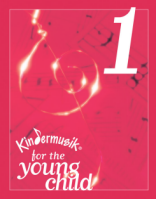|
|
|
|
|
Kindermusik Young
Child 1 (Ages 5 – 7)
|
$80.00/month
|
|
|
|
Why
Kindermusik? >
|
Register Now >
|
Trial a Class >
|
|

|
|
Class Description
|
|
Everything your
child learns later in semesters 2, 3, and 4 begins with this early
introduction to singing, reading, and writing music and rhythm. Through
dances and games that focus on rhythmic development, we'll learn a keyboard
instrument—the glockenspiel—which will be used throughout all the Young Child
classes. Your At Home Materials provide the music,
instruments, stickers, and activities for a home version of the same playful
activities you'll hear about from class, so your child—and you!—can learn where
you're most comfortable: at home.
|
|
Enrollment Includes
|
|
•
Developmentally appropriate curriculum for parents and children, ages 5 – 7
years
•
Class
of no more than 12 children
•
Year-round
classes with a different theme each month
•
Weekly
60-minute class, parent or guardian does not attend class with child
• At Home Materials—Children’s
Folder with stickers, games bag, and Music At Home Cards, Family Songbook,
Home CD of music from class, glockenspiel, and canvas bag (during first
semester).
|
|
What a Parent and
Child Will Experience in Class
|
|
Singing and Vocal Development
|
|
It may sound
like a foreign language when a child sings “ta” and “ti-ti,” but this is the
language of professional musicians and composers and getting young children
ready to read and write simple rhythm patterns.
|
|
Movement
|
|
See children
dance expressively to music, giving them the practice they needs to
coordinate their body movements to the sound of music. This kind of musical
play not only improves musicianship, but physical coordination as well.
|
|
Reading and Writing
|
|
Young children
will learn melodic notation and identify pitches such as the C, A, and D
notes on the treble clef, plus rhythmic notation. Eventually even composing
their own music.
|
|
Focused Listening
|
|
Children will
learn to identify a range of orchestra instruments and their sound qualities,
while also gaining an early awareness and knowledge of composers and
masterworks in Western arts tradition.
|
|
Exploring and Playing Musical
Instruments
|
|
Authentic
percussion, string, pre-keyboard, and woodwind instruments expose children to
the many choices for future musical study, and at the same time provide them
with the opportunity to musically succeed before taking on more formal
instruction.
|
|
Values Group Experience Before Formal
Lessons
|
|
Once
a child begins more formal music lessons, the group dynamic disappears. With Young
Child, children are able to interact and build social skills.
|
|
Creates
a Student Community
|
|
Young Child keeps the same group of children
together for two years, creating an incredible student community.
|
|
|
|
|
|
|
|
|
|
|
|
|
|
|
Unit Details
|
|
|
|
Enroll in August!
|
|
·
Not currently offered
·
Ages 5 - 7 years old
·
60-minute weekly class
|
|

|
|
Lessons
1 - 4
|
|
Music is Everywhere:
We live in a world of sound. As students listen, learn and explore the sounds
that are all around us, they are developing important skills that can enhance
all later learning.
|
|
Lessons 5 - 8
|
|
Ready Steady Go! Musical beats can be fast or slow. They make our
toes feel like tapping and our feet feel like marching. A steady beat is the
underlying pulse of music and of life. Mixing up the steady beat into smaller
and longer pieces give us music! We will listen to the rhythm of weather in
the rain and wind and even a musical storm composed by Beethoven in his
Pastoral Symphony.
|
|

|
|
|
|
Lessons 9 - 12
|
|
The Melody of
Nature: Birds sing to us
with many voices and songs. Melody is the part of music that we want to sing.
The language of melody starts with games about high and low. Join us for
songs, imaginative play and instrument exploration, all exploring MELODY.
|
|
Lessons 13 - 15
|
|
Glockenspiels – Pre
Keyboard Skills! Musical learning for kids who are 4-6 is all
about experiencing music through play and HANDS ON exploration. In this unit
we use the pre-keyboard instrument called a Glockenspiel to organize and
expand learning about steady beat, melody, and rhythm.
|
|
|
|